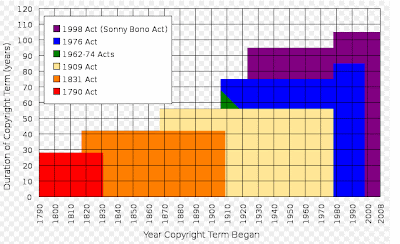"That ideas should freely spread from one to another over the globe, for the moral and mutual instruction of man, and improvement of his condition, seems to have been peculiarly and benevolently designed by nature, when she made them, like fire, expansible over all space, without lessening their density at any point, and like the air in which we breathe, move, and have our physical being, incapable of confinement or exclusive appropriation.” Jefferson, Letter to McPherson, 1813
The thesis of this post is quite simple. If people cannot use materials, images, writings, inventions to build upon, then creativity and innovation will be hampered. If corporations innovate, and then lock down that innovation, so no one else can use it, without paying large fees, then they have effectively imprisoned progress to their own desires and whims. They, and those who they license, will be the only ones to innovate.No doubt, some will see this as an attack on capitalism, or private enterprise. These people will call upon the traditions that made America great. So perhaps it would be good to see what the founding fathers thought about copyright. After the Constitution was adopted in 1787, the Copyright Act of 1790 was passed. In that law an author was given copyright protection for fourteen years, which right could be extended another fourteen years one more time, if, the author was still alive. All laws are written for a purpose. The purpose of copyright law in the United States Constitution is to "promote the progress of Science and useful Arts, by securing for limited Times to Authors and Inventors the exclusive Right to their respective Writings and Discoveries." Article, Section 8. It tries to create a balance between wishing to encourage innovation by giving the author or inventor some protection from infringement, as well as, giving the public the freest possible access to works of authorship and the ideas they encompass.**
Since this Act of 1790, five updates have been made: Copyright Act of 1831 which extended the copyright to twenty-eight years with one additional fourteen year renewal, the Copyright act of 1909, which granted twenty-eight years with an additional twenty-eight year renewal, the Copyright act of 1976, which extended the copyright to seventy-five years with an additional fifty year renewal, the Sonny Bono Copyright Term Extension Act of 1998, which extended the copyright to one hundred and twenty years, with an extension of seventy years. This is a fascinating trend, since as innovation and progress has been speeding up during all this time, it makes no sense to extend the copyright. It should be reduced since its relevance would be lessened by the pace of progress. Here is a chart that illustrates this:
Thus, some works published since 1978 would not become public domain until the year 2047! The question is, are there examples of innovation being hampered by excessive copyright time spans?
Read Only World & Read/Write World
The copyright law as it exists now, and, as it is being interpreted, is at war with the Read/Write World. The Read Only world on the internet is made up of those who only consume culture or information. The Read/Write World is made up of those who not only consume culture but produce it. ITunes is an example of the Read Only World. YouTube is an example of the Read/Write World. Corporate media conglomerates have little understanding of this new Read/Write World. They have a Read Only World mindset.
Creative Commons & Copyleft Movement
The copyleft movement makes software or any other creative work free to all and requiring all modified and extended versions of the program to be free as well. The GNU General Public License is the most common manifestation of the copyleft policy. This license cannot be combined with any other license, but, part of a software from another license can be combined with copyleft software, but then, must be given away for free under the GNU/Copyleft License. Creative Commons of which the Copyleft/GNU is a part, was founded by Lawrence Lessig. He is a professor at Harvard and director of the Edmond J. Safra Foundation for Ethics. He is also on the board of the Software Freedom Law Center and the Electronic Frontier Foundation.
The free software movement has been a great and good influence in the Internet. It has been the license that has produced such programs as Firefox and Wikipedia. It is an expression of the non-corporate free spirit in America.
Read Only World & Read/Write World
The copyright law as it exists now, and, as it is being interpreted, is at war with the Read/Write World. The Read Only world on the internet is made up of those who only consume culture or information. The Read/Write World is made up of those who not only consume culture but produce it. ITunes is an example of the Read Only World. YouTube is an example of the Read/Write World. Corporate media conglomerates have little understanding of this new Read/Write World. They have a Read Only World mindset.
Creative Commons & Copyleft Movement
 |
| Lawrence Lessig |
The free software movement has been a great and good influence in the Internet. It has been the license that has produced such programs as Firefox and Wikipedia. It is an expression of the non-corporate free spirit in America.






No comments:
Post a Comment